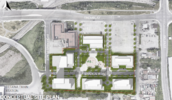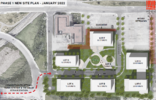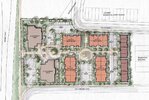From the OBJ:
Colonnade BridgePort targets 2025 start for Pickering Place, Scott Street projects
Ottawa firm's CEO says many development projects remain 'fragile' despite flattening construction costs and expected drop in interest rates
David Sali, OBJ
February 27, 2024 4:16 PM ET
Colonnade BridgePort chief executive Hugh Gorman says the company has “five to 10 years’ worth” of multi-residential development projects in its pipeline and hopes to get a few of them off the ground later this year or early in 2025.
As soaring construction costs level off and interest rates stabilize, a major Ottawa real estate firm is poised to launch several multi-residential housing developments in the coming months – but its CEO warns that many projects are still in limbo as profit margins remain razor thin. Colonnade BridgePort chief executive Hugh Gorman says the company has “five to 10 years’ worth” of multi-residential development projects in its pipeline and hopes to get a few of them off the ground later this year or early in 2025. The firm’s most ambitious proposal is a multi-phased development on a five-acre property at 25 Pickering Pl., just east of the city’s main Via Rail terminal and the Tremblay LRT station. Colonnade BridgePort is partnering with Toronto-based investment firm Fiera Real Estate to turn the current industrial site into a “mixed-use, high-density community hub” that will eventually include up to 1,200 residential units in a mix of rental apartment highrises, condos and retirement residences, as well as retail space, parkland and possibly a hotel. While the project is still going through the site plan approval process, Colonnade BridgePort has started to tear down existing buildings on the property and remediate contaminated soil in anticipation of starting construction on the first phase early next year, Gorman said. Long-term plans call for buildings ranging from 12 to 30 storeys on the site. The first phase will likely include two rental apartment buildings at estimated heights of 14 and 28 storeys near the Via Rail station with a total of about 500 units.
Colonnade BridgePort plans to subdivide the property in the hope of selling some lots to other developers that will build condos and seniors’ housing. The company has had “preliminary” talks with other firms, but condominium projects are a tough sell in the current economic climate, Gorman conceded. “The pro formas are just starting to work on the multi-family side. It’s not so great on the condo side yet. The economics aren’t there.” Many economists are predicting the Bank of Canada will start cutting interest rates later this year. But Gorman said, until that happens, many big-ticket housing proposals will likely remain on hold. “As the projects get bigger, you extend the construction schedule and it creates more risk,” he explained. “We were hoping to see interest rate relief by this time and, of course, that’s not happened yet.” Gorman said the high cost of borrowing money to launch new builds has caused many investors to remain on the sidelines. “The most risky thing to do in real estate is to build something. It’s fraught with downside, and there has to be enough upside to warrant people taking on that risk.” Still, the veteran real estate executive sees signs that brighter days are ahead for the industry.
He notes that construction costs, for example, have finally begun to stabilize after rising dramatically during the pandemic due to supply chain disruptions and skilled labour shortages. After soaring nearly 25 per cent in 2021 compared with the previous year, residential construction costs rose just 1.9 per cent in Ottawa last year over 2022, according to Statistics Canada.
Meanwhile, the general belief that rate cuts are around the corner has prompted capital to start flowing a little more freely, Gorman added.
He said Colonnade BridgePort expects to secure investment partners to help finance a pair of multi-residential rental projects at 2026 Scott St. – the site of the former Granite Curling Club – and nearby 1950 Scott St. within the “next couple of months.” If all goes according to plan, there could be shovels in the ground on Scott Street as early as next spring, Gorman said. “We’ve got economics that are now starting to make sense, and that will in turn start to attract capital back to the market because the demand side of the curve from tenants and the revenue side of the pro forma is very, very strong,” he explained. In addition, the firm plans to start work this July on a 12-storey, 124-unit “boutique” rental complex on Argyle Avenue near the Canadian Museum of Nature.
“On multi-family (projects), we’re just getting to the point where we can get the economics and the pro forma to work,” Gorman said. “That’s why we’re much more bullish on the multi-family rental side.” But as the City of Ottawa pushes toward its target of adding 151,000 new housing units by 2031, Gorman said developers continue to run up against roadblocks such as rising development charges and increases in other costs levied by the city, such as fees in lieu of parkland.
In addition, he said timelines for approving development projects are “still dragging” despite the city’s efforts to hire more staff and streamline the process. “There are definitely challenges related to everything from permitting fees, development charges and infrastructure costs that are hugely impactful on the pro forma and making it very challenging to build,” Gorman said.
“We’re quite confident in (certain) projects proceeding this year, but I would say that we’re on the cusp of those projects working, and they’re fairly fragile.” Gorman said he’d like to see a moratorium on all development charges, a reduction in permitting fees, and more fast-tracking of development applications – particularly for projects near transit hubs that will add more density to Ottawa’s core and help limit urban sprawl.
“You could say, well, obviously I’m a developer and I’m advocating for my own best interests. But I think you’ve got to take a broader view on these things,” he said.
“We need housing across the spectrum – we need supportive housing, we need affordable housing, we need (market-value) housing. It is a for-profit industry for a reason, and if there’s no capability to get capital to agree that the risk is worth the return, we’re not going to have any new supply. Just because a few projects get going, it doesn’t mean that we’re going to solve the problem.”












